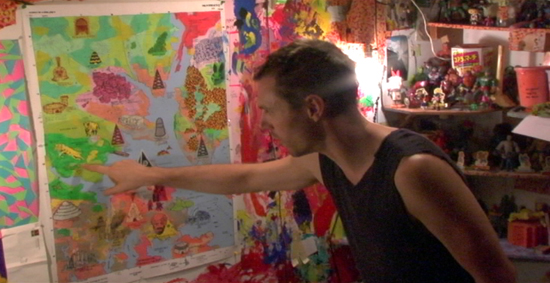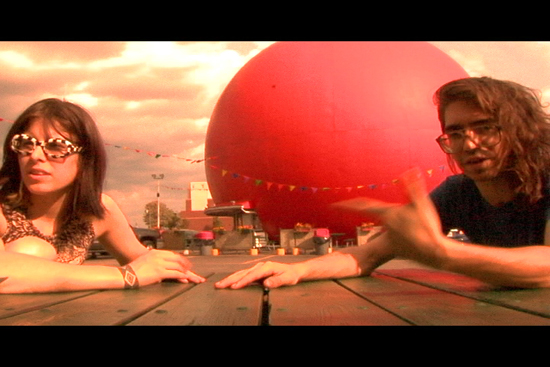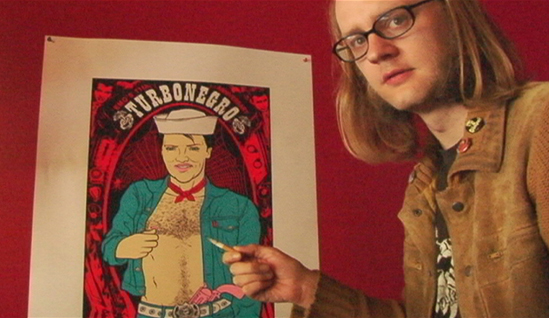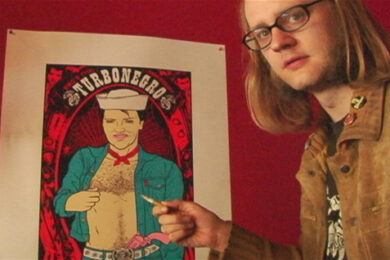Do you remember the music posters you tacked to your teenage bedroom wall? Did the posters’ iconography play a significant part in your adolescent scenery? Judging by the evidence of Died Young, Stayed Pretty, poster artistry left a marked imprint on director Eileen Yaghoobian’s evolving mind. For the Iranian-born Canadian filmmaker has created, in her debut full-length, a (rocku)documentary that follows not the bands of her youth but the artists of their show posters.
Yaghoobian interrogates the figures of the North American underground print scene; her subjects are outsider oddballs, entrepreneurs of art and dedicated purveyors of alternative music. From bizarre encounters to blasphemous rants, hedonistic anecdotes to beautiful reflections, Yaghoobian’s exposure of the poster makers’ craft — and the philosophies surrounding it — dissects both the nature of the artists’ palettes, and that of the sub-culture(s) they play a part in. Just what, or who, should a sub-culture stand for, the film asks. And when underground and overground converge, what are the cultural consequences?
The work of the featured artists spans states and decades, but most print collectives began creating in the mid-90s in synchrony with the birth of grunge. We meet, among others, Art Chantry, who splashed out the logos for bands such as Nirvana, Hole and The Sonics; Rob Jones, creator of The White Stripes’ visual trademark; and Brain Chippendale of Lightning Bolt infamy. We hear too from The American Poster Institute, a non-profit organisation committed to supporting the poster art form as a collective endeavour.

These artists may be scattered across North America, but their ethos is shared: collect, recycle and re-work the old; collage, sketch and screen-print the new. We see inside studios with walls covered floor-to-ceiling in doodles. We watch ink swell across screen-printing equipment, pools of blood-red pigment marbling into fluorescent day-glo tones. We hear how collections of catalogued images are filed and flicked through till they spill out of drawers. We check poster stacks and portfolios that threaten to bury their makers in volume. The artists appear as the assiduous underdogs of what is primarily a punk scene, and what is punk — one artist asks — if not the flowers in the dustbin?
This art, whether viewed as disposable or die-hard, is closely entangled in rock music culture: it exists, at least in its conception, to promote entertainment, to make seen that music which the mainstream does not hear. Whereas the concerts of bands from Mötley Crüe to Menomena draw the kids of alternative scenes, the posters are placed in positions where they may speak out more widely, to confront the masses on the street. As one artist puts it, a poster taped to a lamppost has the potential to “shake up the squares” on their commute to work, leaving the home territories of the underground to challenge passers-by, pushing obscene or obscure graphics into the blur of public space.

We learn how many of the bands of the Eighties and Nineties scenes were funded by illegal activity — not only by drugs, but also prostitution. The posters’ artwork openly responds to this: cartoon naked ladies pose with chests out and guns in their mouths; The Flaming Lips’ set times are scrawled over a female crotch. Mainstream culture is stripped of its images, from Fifties porn prints to vintage car magazines and Elvis’ promotional designs. The art on the posters should be as raw as the music they promote, the film proclaims; their designs as sharp as the hooks, their graphics as rebellious as the lyrics.
It gradually becomes clear, though, that after the posters’ inspired debt to the subjects of their publicity comes a visual documentation in its own right. These are the prints that track the sounds of a sub-culture, yes, but such illustrated records possess a life span that lasts beyond the moment of the shows. The posters may have initially been made with a throwaway punk spirit in mind, but together, they construct a barrage of printed paraphernalia.
So does the film deal in cultural artefacts or cultural detritus? Throughout the interviews, the question of recording a trace — of an event, a group, an identity — recurs. The film supports the printmaker’s craft via its own design, mirroring the active collage of the poster-making process in its edited frames. Dialogues are spliced in pieces to be later re-assembled in a pick-and-mix, cut-and-paste style. The director’s photographic experience, meanwhile, (her work is displayed in permanent collections in the US, Canada, and France) surfaces in still shots of kaleidoscopic colour, which are inserted between the dialogic fragments to form a disjointed montage. Mark Greenberg’s soundtrack makes a fittingly discordant partner.
Will the show posters be lost, burnt, or forgotten, along with rock’s tattered remains? Ultimately, the worth and fate of all these scattered sheets is left for the viewer to decide. Yet in prompting such spoken material, the film maps the movements of cultural activity, and exposes where the borders of this activity lie. In salvaging this sub-culture, Yaghoobian creates a secondary trace — a further visible layer to rock ‘n’ roll and its identities.



